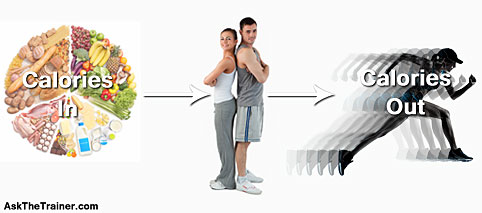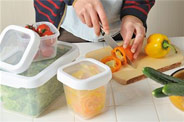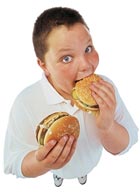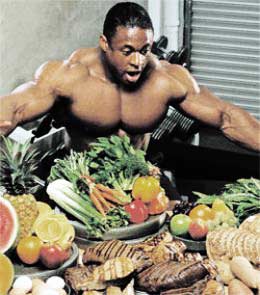- Like
- SHARE
- Digg
- Del
- Tumblr
- VKontakte
- Flattr
- Buffer
- Love This
- Save
- Odnoklassniki
- Meneame
- Blogger
- Amazon
- Yahoo Mail
- Gmail
- AOL
- Newsvine
- HackerNews
- Evernote
- MySpace
- Mail.ru
- Viadeo
- Line
- Comments
- Yummly
- SMS
- Viber
- Telegram
- JOIN
- Skype
- Facebook Messenger
- Kakao
- LiveJournal
- Yammer
- Edgar
- Fintel
- Mix
- Instapaper
- Copy Link
 Reality Check: Weight Loss is Hard Work!
Reality Check: Weight Loss is Hard Work!
Anyone who tells you weight loss is easy is lying to you and most likely trying to sell you something! While losing the extra weight is not easy, it’s absolutely worth your time and effort. Healthy weight loss and improved fitness will elevate your health, fitness, and happiness, giving you more energy for your family and for your work life as well.
If you want quick tips for weight loss, I have to tell you that you’ve come to the wrong place. I’m going to go over ten tips and tricks for effective, sustainable, long-term weight loss where the pounds you lose will stay off. This kind of weight loss can be more accurately called “fat loss”, as you will be losing extra body fat rather than muscle weight or water weight.
If you’re serious about losing the fat and keeping it off, keep reading.
#1. Limit Your Caloric Intake
 In most cases, losing weight boils down to a numbers game. You need to burn more calories than you are eating. Although you burn a baseline level of calories throughout your day to day activities, the best way to raise your caloric burn is to engage in regular vigorous exercise.
In most cases, losing weight boils down to a numbers game. You need to burn more calories than you are eating. Although you burn a baseline level of calories throughout your day to day activities, the best way to raise your caloric burn is to engage in regular vigorous exercise.
And as we all know, the best way to lower your caloric intake is to watch what you eat. For most women, in order to lose one pound of body fat in one week, you need to create a deficit of 3,500 calories in that 7-day period. That’s 500 calories per day. A simple way to do that is to cut 250 calories from your diet and make sure you burn at least 250 extra calories through stepping up your workout.
Don’t dip below 1200 calories in an attempt to speed up your weight-loss, though. Fewer than 1200 calories causes your body to go into starvation mode and hang on to fat. You may lose weight on that kind of diet- but it will be muscle and water, and it will come right back as soon as you start eating normally again.
#2. Drink Plenty of Fluids
 Dehydration can easily be mistaken for hunger. Get in the habit of drinking liquids throughout the day to avoid becoming super thirsty. Feelings of thirst indicate that you are already dehydrated. Especially if working out is part of your weight loss plan (and it should be!) you will need to consume lots of fluids.
Dehydration can easily be mistaken for hunger. Get in the habit of drinking liquids throughout the day to avoid becoming super thirsty. Feelings of thirst indicate that you are already dehydrated. Especially if working out is part of your weight loss plan (and it should be!) you will need to consume lots of fluids.
Good old fashioned water is the best source of fluid for your body. Avoid sports drinks and juices. You’re getting excess sugar calories and/or artificial sweeteners which come with their own set of problems.
If you get bored of nothing but water all the time, try mixing it up with unsweetened green or herbal tea. Alternatively add lemon, lime, cucumber, or fresh mint to your water to make hydrating more enjoyable.
Make sure you drink a big glass of water before eating a meal to help you feel more full and avoid overindulging.
#3. Eat Fresh, Whole Foods That You Prepare at Home
 When you purchase and prepare most of your own food, you are bringing a whole new level of mindfulness to your eating. You are able to select all the ingredients and choose your own portions.
When you purchase and prepare most of your own food, you are bringing a whole new level of mindfulness to your eating. You are able to select all the ingredients and choose your own portions.
When you eat out all the time, you’re being loaded up with excessively large portions of highly processed foods full of sodium. You might be staggered to learn how many calories are in restaurant meals. It’s easy to go ahead and clean your whole plate when you’re in a restaurant setting, because “everyone is doing it”.
When you eat mostly at home, or eat food you have prepared yourself when you have to eat on the run, you’re more in touch with your body and what you are putting into it.
#4. Get your Family on Board
 When you’re changing your eating patterns, you need as much support as you can get to make it as easy on yourself as possible. Changing up your diet works best if the whole family makes the transition.
When you’re changing your eating patterns, you need as much support as you can get to make it as easy on yourself as possible. Changing up your diet works best if the whole family makes the transition.
For some families, of course, this is easier said than done. See if you can somehow turn it into a game or a family challenge with prizes for whoever does the best job sticking to the plan, cooks the most meals, etc.
#5. Get Super-Stoked on Veggies
 Mother Nature sure has been good to us, providing all these tasty and nutritious veggies!
Mother Nature sure has been good to us, providing all these tasty and nutritious veggies!
There is a world of vegetables out there just waiting to be discovered. You can bake them, sauté them, steam them, blend them in smoothies, make salads, even just munch on them raw!
Make up the bulk of your diet with veggies and you will feel full as well as receive tons of vitamins, minerals, and phytonutrients. The fiber will help you feel satisfied with your meals and flush out your digestive system, making you better able to absorb the nutrients from your food.
And since most veggies are naturally low-calorie, when you make them the base of your diet rather than grains, you will be getting a big leg up on the calorie game.
#6. Build a Healthier Relationship With Food
 Look at your food the fuel your body needs, not as a medication for your emotions. Many of us are emotional eaters. Some of the most common reasons for emotional overeating include loneliness, frustration, anxiety, and boredom.
Look at your food the fuel your body needs, not as a medication for your emotions. Many of us are emotional eaters. Some of the most common reasons for emotional overeating include loneliness, frustration, anxiety, and boredom.
Next time you find yourself craving something that is NOT fuel, or wanting to overeat healthy foods, see if you can identify what emotions you are feeling. Do something related to emotional expression or self-care rather than reaching for extra food. Maybe you’ll see a pattern emerging over time.
The more mindful your relationship with your eating patterns, the less likely you will be to fall into the emotional eating trap.
#7. Stop Rewarding Yourself With Food
 Come up with a different way of giving yourself kudos than indulging in excess food. Many of us tend to do this consciously or subconsciously, doing calculations in our heads to see how much cheat food we have “earned”, either through doing tough workouts, putting up with extra B.S. at work, finishing our midterm exams, etc.
Come up with a different way of giving yourself kudos than indulging in excess food. Many of us tend to do this consciously or subconsciously, doing calculations in our heads to see how much cheat food we have “earned”, either through doing tough workouts, putting up with extra B.S. at work, finishing our midterm exams, etc.
While it’s great to give yourself rewards that you enjoy, always going for food is a quick way to end up with lots of extra calories and frustrated weight loss goals. Instead of food, reward yourself with music, a new shirt, or trying something you have always wanted to do like going to a yoga class.
#8. Plan Your Meals…
 …and stick to the plan! Remember what they say about the road to hell being paved with good intentions. In order to break suboptimal eating patterns, it REALLY helps to make a meal plan that includes breakfast, lunch, dinner, and healthy snacks.
…and stick to the plan! Remember what they say about the road to hell being paved with good intentions. In order to break suboptimal eating patterns, it REALLY helps to make a meal plan that includes breakfast, lunch, dinner, and healthy snacks.
Set some time aside each week to sit down with a notebook and map out your week. Plan tasty, balanced, veggie-based meals that include carbs, protein, and good fats. Then, make a shopping list of everything you will need to make the meals and snacks. Eat before you go to the grocery store so you’re not shopping while hungry.
When you get home, prepare as much of the meals as you can ahead of time. Wash, chop, and pack up veggies, measure out grains, etc. Even pre-cook as much as you can. Do as much as you can to set yourself up for success in the week to come. Stay with the plan throughout the week.
Allow yourself one big cheat meal per week or a few smaller indulgences along the way so you don’t feel deprived. If you’re too restrictive, you’re more likely to binge later at a time when your resolve feels weak.
#9. Stay on Point Even After Reaching Your Goal Weight
 When you reach your weight loss goal, it can be tempting to fall back into your old habits of overindulging in empty calories. Don’t let that happen! You will end up back where you started.
When you reach your weight loss goal, it can be tempting to fall back into your old habits of overindulging in empty calories. Don’t let that happen! You will end up back where you started.
Remember that eating better is NOT just about weight loss, it’s about HEALTH! You need to keep eating a healthy, nutritious diet even when your body composition arrives exactly where you’d like it to be.
Eating right will support your sustainable weight loss as well as give you more energy for fitness pursuits and daily life.
#10. Enjoy eating!
 While this last tip may sound counterproductive since this is likely one of the big reasons you are trying to lose weight to begin with, enjoying the food you eat is a crucial piece of the fat loss puzzle. After all, if you don’t enjoy eating healthy foods, you’re likely going to fall off the wagon and indulge in your old counterproductive habits of eating unhealthy again.
While this last tip may sound counterproductive since this is likely one of the big reasons you are trying to lose weight to begin with, enjoying the food you eat is a crucial piece of the fat loss puzzle. After all, if you don’t enjoy eating healthy foods, you’re likely going to fall off the wagon and indulge in your old counterproductive habits of eating unhealthy again.
The trick here is trying different healthy options and compiling a list of the ones you find most pleasurable to eat. Once you begin eating these pleasurable healthy foods regularly, you will start to train your palate to prefer them. In fact, you will likely no longer crave the unhealthy ones that you loved so much in the past. The thought of fast food, for example, may even make you feel sick to your stomach.
Of course, you’re not always going to like every healthy food you try, but before you scratch one off your list, give the following a try. For example, if you don’t like raw broccoli, try cooking it using a different recipe (e.g., steamed broccoli with lemon) and see if that makes a difference. The key here is to broaden your horizons by trying different foods and recipes. Many of us hit a roadblock because we just don’t take the time to do so. This extra time is well worth the effort since the more healthy foods you like, the more likely you are going to stick to a healthy diet!
The Bottom Line
Remember that to lose the extra pounds of fat, you are changing fundamental aspects of your life such as your eating habits, your activity level, how you think about yourself and feel toward yourself, etc. You must also find extra time in your day to shop for and prepare healthy meals.
All in all, you’ll have to change daily rituals that may have been your standard M.O. for years. Remember that weight loss is a big commitment you are making to yourself and to your family and loved ones.
Seek the support of friends, family, even online groups. You’re not alone! Stay positive, be patient, and you will be rewarded with lasting weight loss as well as improved well-being and vitality for life.
Did we miss any of your favorite weight loss tips? Let us know in the comments below!
About Mae Barraclough
Mae Barraclough, B.S., NASM-CPT, NASM-CES is a certified personal trainer, corrective exercise specialist, and licensed Zumba Instructor. With her passion for health, fitness, and dance, Mae loves learning all she can and sharing her knowledge with others.


All good advice except the calorie counting part. Calories in does NOT equal calories out!!! While we’ve all been duped for 40 years or more into believing this is true — nothing could be further from it. If someone is actively “working out”, then the focus should be in other areas besides calorie counting: limiting carbohydrate intake (particularly from bad sources, like sugars, starches), ensuring adequate protein levels to that match your level of activity in order to repair and restore muscle tissue, adequate amounts of “good” (monounsaturated) fats, and proper Omega-3 ratios. As long as you have good food choices, your hormones (primarily leptin and insulin) will guide your energy and satiety levels.